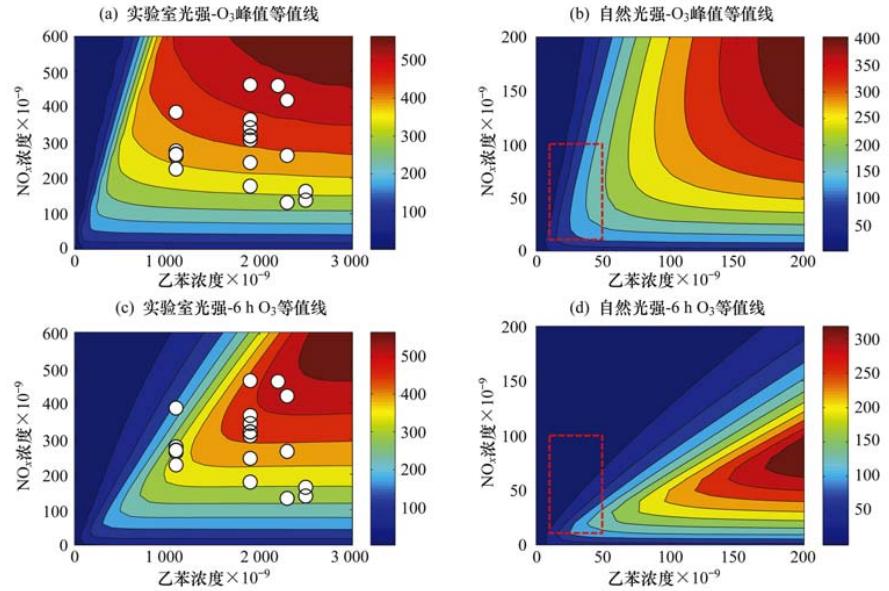烟雾箱与数值模拟研究苯和乙苯的臭氧生成潜势
组内消息 2014-01-13
结合光化学烟雾箱实验与数值模拟研究了苯和乙苯在NOx存在条件下的光氧化臭氧生成潜势. 重复实验表明,在乙苯-NOx反应体系中,反应物初始浓度、温度、湿度和光照强度接近的条件下,整个反应过程中臭氧的最大偏差仅为4%,证明了烟雾箱的可重复性较高. 在烟雾箱实验的基础上,使用MCM (master chemical mechanism)模拟了苯和乙苯的光氧化O3生成,并将其结果与实验数据进行了比对分析. 干燥(≤5%)时MCM对苯和乙苯的模拟结果与实验结果较接近,如在苯-NOx反应体系中,MCM模拟的O3峰值比实验值偏大20%;在湿度为5%~70%时,MCM模拟的乙苯光氧化O3峰值与实验值偏高约(10%~25%). 用MCM模拟了太阳光照条件下苯和乙苯的臭氧生成等值线,得到在它们浓度为(10~50)×10-9,NOx在(10~100)×10-9时,苯和乙苯的6 h臭氧贡献值分别为(3.1~33)×10-9和(2.6~122)×10-9,臭氧峰值范围分别是(3.5~54)×10-9和(3.8~164)×10-9. 此外,模拟得到苯和乙苯的最大增量反应活性(maximum incremental reactivity,MIR)值分别为0.25/C和0.97/C (每单位碳). 该结果与Carter通过SAPRC机制得到的MIR值趋势一致. 模拟得到苯和乙苯的最大臭氧反应活性(maximum ozone reactivity,MOR)分别为0.73/C和1.03/C. 苯的MOR值远高于Carter使用SAPRC得到的结果,说明根据Carter得到的苯MOR会低估苯的O3潜势.

贾龙, 徐永福. 烟雾箱与数值模拟研究苯和乙苯的臭氧生成潜势. 环境科学, 2014,35(2):495~503 全文下载
Studies of ozone formation potentials for benzene and ethylbenzene using a smog chamber and model simulation
Jia Long,Xu Yong fu
Ozone formation potentials from irradiations of benzene-NOx and ethylbenzene-NOx systems under the conditions of different VOC/NOx ratios and RH were investigated using a characterized chamber and model simulation. The repeatability of the smog chamber experiment shows that for two sets of ethylbenzene-NOx irradiations with similar initial concentrations and reaction conditions, such as temperature, relative humidity and relative light intensity, the largest difference in O3 between two experiments is only 4% during the whole experimental run. On the basis of smog chamber experiments, ozone formation of photo-oxidation of benzene and ethylbenzene was simulated in terms of the master chemical mechanism (MCM). The peak ozone values for benzene and ethylbenzene simulated by MCM are higher than the chamber data, and the difference between the MCM-simulated results and chamber data increases with increasing RH. Under the conditions of sunlight irradiations, with benzene and ethylbenzene concentrations being in the range of (10-50)×10-9 and NOx concentrations in the range of (10-100)×10-9, the 6 h ozone contributions of benzene and ethylbenzene were obtained to be (3.1-33)×10-9 and (2.6-122)×10-9, whereas the peak O3 contributions of benzene and ethylbenzene were (3.5-54)×10-9 and (3.8-164)×10-9, respectively. The MCM-simulated maximum incremental reactivity (MIR) values for benzene and ethylbenzene were 0.25/C and 0.97/C (per carbon), respectively. The maximum ozone reactivity (MOR) values for these two species were obtained to be 0.73/C and 1.03/C, respectively. The MOR value of benzene from MCM is much higher than that obtained by carter from SAPRC, indicating that SAPRC may underestimate the ozone formation potential of benzene.




